Discover Muğla’s 10 Must-See Ancient Cities and Archaeological Sites
Although part of it falls within the Mediterranean Region, Muğla, mostly surrounded by the Aegean Sea, is situated in Turkey's southwestern corner in a unique landscape where history and nature are interconnected. These ancient lands, home to diverse civilisations throughout history, offer visitors a journey through time with their rich archaeological sites and impressive ruins. Muğla hosts 103 registered archaeological sites. Its history is deeply rooted, from the indigenous Carians of Anatolia to the Hellenistic civilisations that followed, as well as the Median and Persian empires. This distinctive city, bearing the marks of many civilisations, is a cultural treasure of the Aegean Region.
So, what are the must-see historical cities in Muğla? What to do in Muğla as a history lover? Let's explore together!
1. Lagina Ancient City

The ancient city of Lagina, also known as ‘Leyne’, is located in the Yatağan district of Muğla. Archaeological finds show that the traces of settlement in this region date back to the 3rd millennium BC. Lagina, which has been used as an uninterrupted settlement since ancient times, stands out especially with its religious buildings.
The most remarkable feature of the city is the temple dedicated to Hecate, the chief goddess of Ancient Caria. This sanctuary includes a monumental propylon (entrance gate), sacred road, altar area, stoa with Doric columns and various cult structures. The friezes decorating the surroundings of the Temple of Hecate are like a legendary narrative engraved on stone. In these friezes, the life of Zeus, the war between the Amazons and the Greeks, the mystical depictions of Hecate and the depictions of the gods of Caria dazzle the eye.
The sacred buildings, which were ruined after the looting in 40 BC, were rebuilt with the donations made by Emperor Augustus in 27 BC. The inscription of this donation has also survived to the present day. If you want to observe the mythological scenes and feel the atmosphere of a fascinating religious centre, we recommend that you put Lagina Ancient City at the top of your list.
2. Herakleia Ancient City (Latmos)
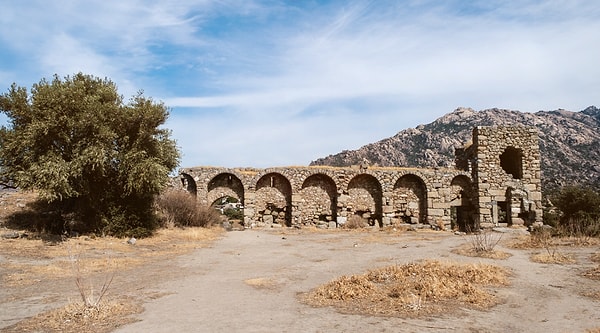
The ancient city of Herakleia, located in the vicinity of today's Milas-Söke, in the region known as Latmos Bay and Latmos Mountains in ancient times, is a historical treasure hidden in the rich nature of the Beşparmak Mountains.
This city, also called ‘Latmos’ and ‘Latmia’, developed, enriched and became an important settlement thanks to maritime trade, especially during the Hellenistic Period. However, Herakleia has a very special aspect that distinguishes it not only with its architecture but also with its wall paintings. The figurative drawings found here are thought to symbolically depict the first known family representations in Anatolia.
These rock paintings reflect the transition from the Palaeolithic to the Neolithic Age and, unlike similar examples in Europe, they are free of violence and war figures. These unique depictions, which bear the traces of a peaceful life, are the only ones of their kind in Western Anatolia. Herakleia, where art, nature and history are intertwined, is a wonderful discovery route that can be combined with nature walks.
3. Letoon Ancient City

Letoon Ancient City, which has been on the UNESCO World Heritage List since 1988, is located near the Fethiye district of Muğla and is known as one of the most important religious and political centres of the Lycian civilisation. According to ancient sources, the city was founded in the 7th century BC and is known as the cult centre of the Goddess Leto.
Letoon has three temples located side by side: The Doric temple dedicated to Apollo, the Ionic temple dedicated to Leto and a smaller structure dedicated to Artemis. Due to the rising water level, the floors of these buildings are now partially underwater, which gives the temples a mystical appearance.
In addition, multilingual inscriptions written in Greek, Aramaic and Lycian were found here. These inscriptions both reflect the multicultural structure of the city and provide important information about the history of Lycia. The Hellenistic theatre in the north of the city is well preserved and reflects the architectural elegance of the ancient period. There is a water fountain to the southwest of the temples and the remains of a church to the east. Letoon, where the ancient atmosphere is still felt, is a fascinating stop for those who want to trace the traces of the past.
4. Stratonikeia Ancient City
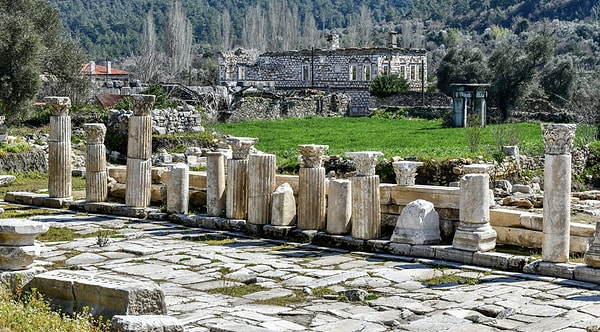
Stratonikeia Ancient City, located on the Muğla-Bodrum highway, is a multi-layered settlement centre founded in the 3rd century BC and witnessed the Hellenistic, Roman, Byzantine, Ottoman and Republican periods. According to archaeological excavations, the region has seen uninterrupted settlement from the Late Bronze Age to the present day.
The largest gymnasium of Anatolia is located in the ancient city. The bouleuterion, which is also the city council, is one of the impressive buildings in the centre. Visitors can see many structures from the ancient theatre to the Roman baths, from the agora to the necropolis areas. However, religious buildings of different faiths such as temples, churches and mosques coexist within the city limits.
Another remarkable aspect of Stratonikeia is the stone-paved roads of the Ottoman period and the traditional buildings that are still standing. With these features, the ancient city is not only an archaeological site, but also a ‘living city museum’. This special city, which carries uninterrupted traces from the past to the present, offers its visitors the privilege of seeing the cultural and architectural transitions made throughout history in the same place.
5. Ancient City of Knidos
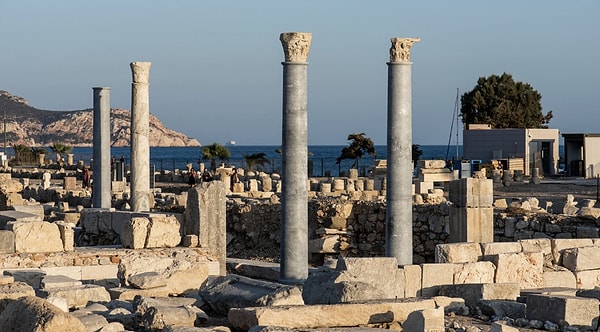
The ancient city of Knidos, located at the point where the Aegean and the Mediterranean meet on Cape Tekir, is one of the most important coastal cities of Western Anatolia. Knidos, one of the important settlements of the Carian region, was built as a terraced city due to its geographical structure. In this city divided by parallel streets and roads, ancient examples of urban planning are remarkable.
Knidos was built on both the mainland and a small island connected to it. The acropolis, the highest point of the city, stands out with its impressive view. The remains of the city walls built in the 4th century BC surround the city and offer traces of the defence system. As you move eastwards, you come across the necropolis area.
There are also important sacred buildings such as the Sanctuary of Demeter, the Temple of Aphrodite and the Temple of Dionysus. It is known that the Temple of Aphrodite once exhibited the famous Aphrodite statue of the sculptor Praksiteles. There are 7 churches in the ancient city, which indicates the importance of the city in the Byzantine period. Although only the remains of the walls of the theatre have survived to the present day, it is possible to trace the traces of a different civilisation on every stone of Knidos. Located by the sea, this city also fascinates its visitors with its unique sunset views.
6. Kaunos Ancient City
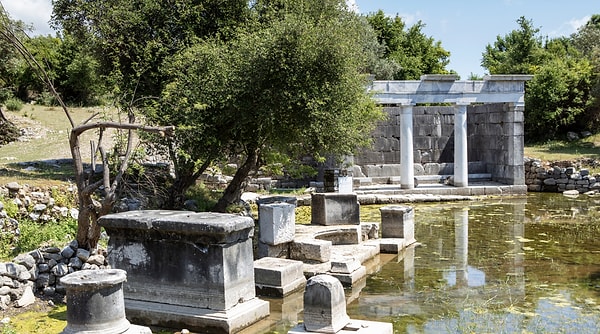
Kaunos Ancient City, located within the borders of the Ortaca district of Muğla, close to the point where the Dalyan River flows into the sea, is one of the most impressive ancient settlements of the region. Kaunos, one of the important cities of the Lycian region, is especially famous for its rock tombs. The huge rock tombs surrounding the city are considered among the unique examples of the tomb architecture of the ancient world.
Structures such as the theatre, agora, baths and city walls from the Roman period reveal the rich history of Kaunos. The city, which is intertwined with natural beauties, can be reached by boat from the shore of the Dalyan River. Kaunos, which is an indispensable point for history and nature lovers, also functioned as an important harbour city in ancient times.
7. Tlos Ancient City

Tlos Ancient City, located in the Seydikemer borders, about 40 km from the Fethiye district, is one of the oldest and most important centres of Lycian civilisation. The city, which is the subject of the legends of the mythological hero Bellerophon, is located on a high hill and forms an impressive archaeological complex with the surrounding area.
There are an agora, a theatre, a stadium, an acropolis and rock tombs in the city. Tlos has been of great importance both militarily and religiously throughout history. Archaeological ruins combined with their natural environment offer visitors both a cultural journey and a nature walk.
8. Telmessos Ancient City
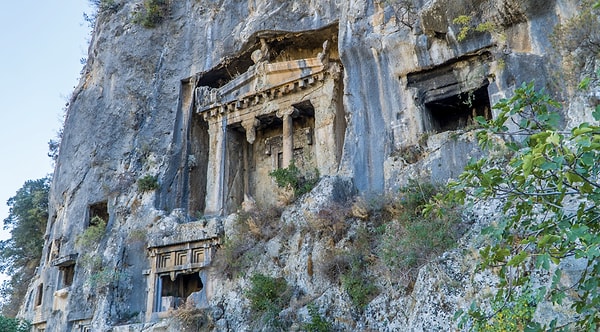
Located in Fethiye city centre, Telmessos Ancient City stands out with its ease of transportation and rich archaeological heritage. King Amintas Rock Tomb, the most remarkable structure of the city, attracts the attention of visitors, especially with its sunset view.
Telmessos, enriched with ancient theatre and other tomb structures, is one of the most important settlements of Lycia. This ancient city, which is located in the city life, offers a special atmosphere where both history and daily life are intertwined.
9. Iassos Ancient City
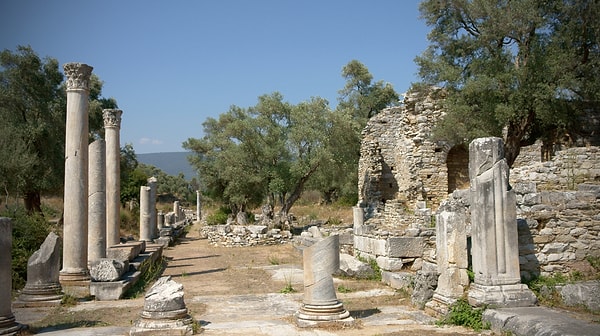
The ancient city of Iassos, located near the village of Kıyıkışlacık in Milas district, is an important port city on the Aegean Sea coast. It attracts attention with its ancient theatre, agora, baths and especially the ruins of the ancient fish market.
Iassos was a strategic trade and maritime centre in ancient times. Besides being a harbour city, it is one of the important stops of cultural tourism with its rich structural diversity and well-preserved ruins. It is an ideal route for those who want to explore ancient ruins accompanied by sea views.
10. Ancient City of Pinara

Located around Minare Village, about 25 km from Fethiye, the Ancient City of Pinara is one of the other important cities of the Lycian region. Attracting attention with its ancient theatre, temple ruins and especially thousands of rock tombs, Pinara offers a calm and natural visit experience.
For those who want to discover nature away from the crowds, Pinara offers the perfect combination of history and nature. This ancient city, where you can breathe the mystical atmosphere of Lycian civilisation, is one of the hidden treasures waiting to be discovered.
Keşfet ile ziyaret ettiğin tüm kategorileri tek akışta gör!

Send Comment